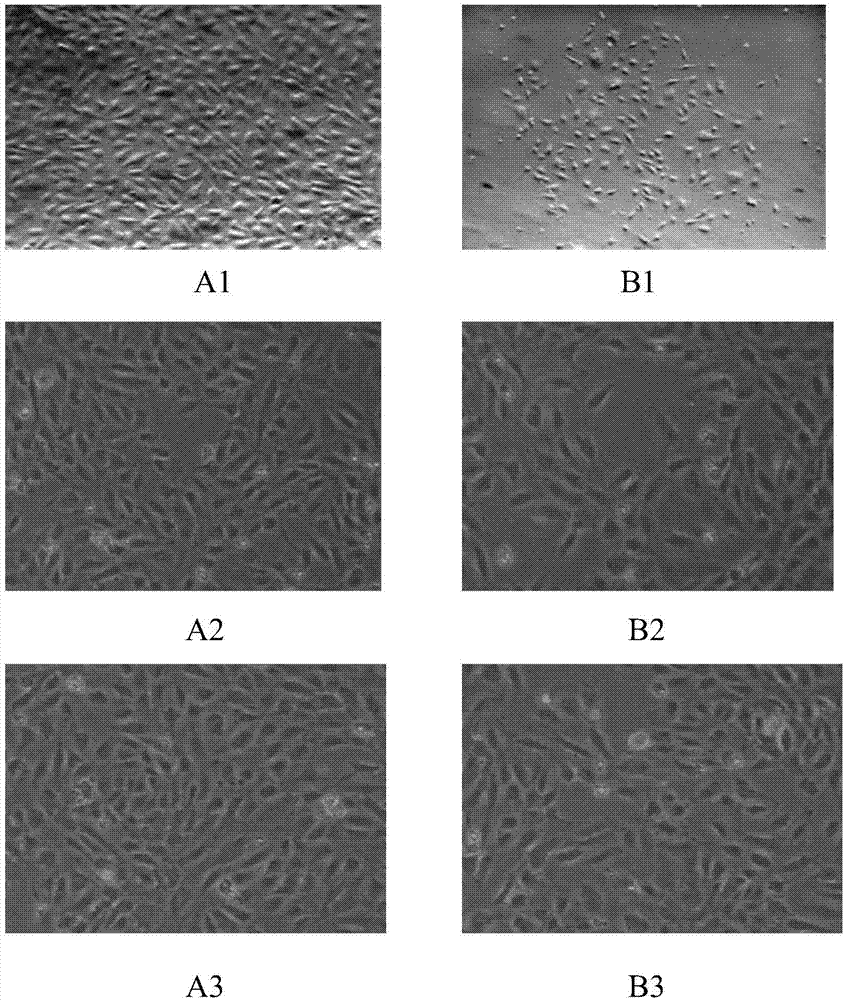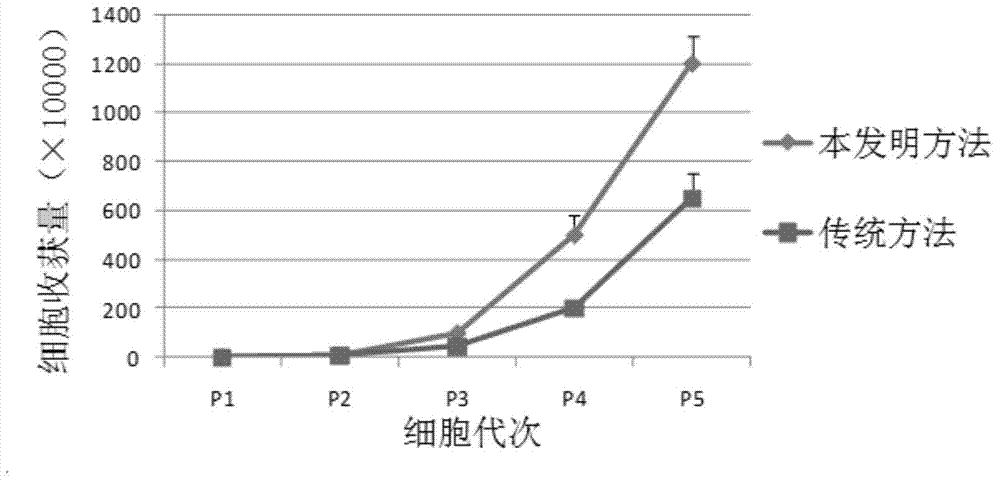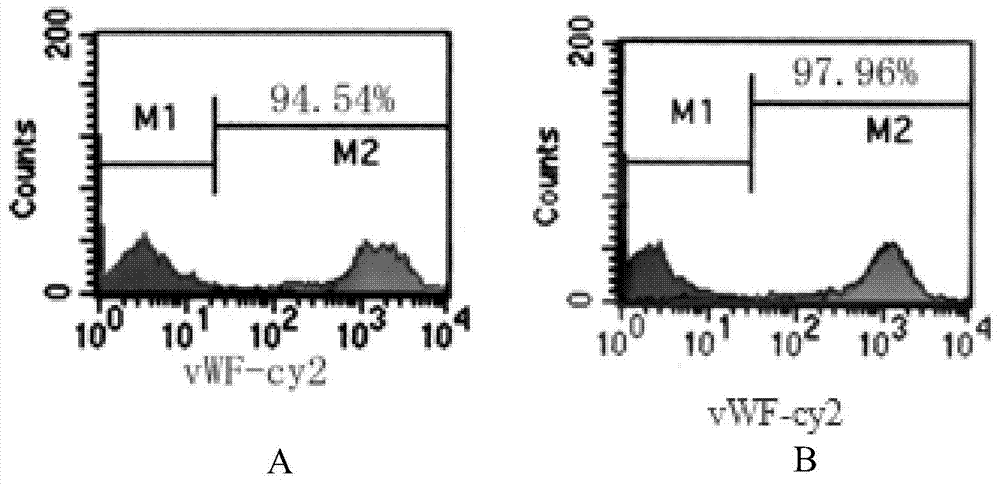Separation culture method for endothelial progenitor cells and kit of method
An endothelial progenitor cell, separation and culture technology, which is applied in the field of the separation and culture method of umbilical cord blood endothelial progenitor cells and a kit thereof, can solve the problems of limited endothelial progenitor cells, low amplification efficiency, slow cell proliferation and the like, and achieves cell surface antigen The effect of high expression rate, large cell harvest, and high cell confluency
- Summary
- Abstract
- Description
- Claims
- Application Information
AI Technical Summary
Problems solved by technology
Method used
Image
Examples
Embodiment 1
[0040] Example 1 Isolation and culture of umbilical cord blood EPCs
[0041] Umbilical cord blood was obtained from the umbilical cords of full-term healthy newborns, anticoagulated with compound sodium citrate (CPD-A), and separated within 24 hours after collection.
[0042] Dilute the umbilical cord blood with PBS at a ratio of 1:1, centrifuge at 400g at 20°C for 10 minutes, discard the supernatant and fat layer, resuspend the cell pellet with an appropriate amount of PBS, and carefully add an equal volume of Ficoll-paque lymphocyte separation medium (density 1.077× 10 3 g / L), centrifuge at 600g for 30min at 20°C, and collect the mononuclear cell layer.
[0043] After washing twice with PBS, the mononuclear cells were resuspended in DMEM+10% FBS complete culture solution, and the cell concentration was adjusted to 10 7 / mL, planted in a 35mm Petri dish covered with gelatin, the culture condition is DMEM medium containing 10% FBS, add VEGF 20ng / mL, FGF 20ng / mL, IGF 1ng / mL, ...
Embodiment 2
[0046] Example 2 Isolation and culture of umbilical cord blood EPCs
[0047] Umbilical cord blood was obtained from the umbilical cords of full-term healthy newborns, anticoagulated with compound sodium citrate (CPD-A), and separated within 24 hours after collection.
[0048] Dilute the umbilical cord blood with PBS at a ratio of 1:1, centrifuge at 400g at 20°C for 10 minutes, discard the supernatant and fat layer, resuspend the cell pellet with an appropriate amount of PBS, and carefully add an equal volume of Ficoll-paque lymphocyte separation medium (density 1.077× 10 3 g / L), centrifuge at 600g for 30min at 20°C, and collect the mononuclear cell layer.
[0049] After washing twice with PBS, the mononuclear cells were resuspended in DMEM+10% FBS complete culture solution, and the cell concentration was adjusted to 10 7 / mL, planted in a 35mm Petri dish covered with gelatin, the culture condition is DMEM medium containing 10% FBS, add VEGF 20ng / mL, FGF 20ng / mL, IGF 1ng / mL, ...
Embodiment 3
[0052] Example 3 Isolation and culture of umbilical cord blood EPCs
[0053] Umbilical cord blood was obtained from the umbilical cords of full-term healthy newborns, anticoagulated with compound sodium citrate (CPD-A), and separated within 24 hours after collection.
[0054] Dilute the umbilical cord blood with PBS at a ratio of 1:1, centrifuge at 400g at 20°C for 10 minutes, discard the supernatant and fat layer, resuspend the cell pellet with an appropriate amount of PBS, and carefully add an equal volume of Ficoll-paque lymphocyte separation medium (density 1.077× 10 3 g / L), centrifuge at 600g for 30min at 20°C, and collect the mononuclear cell layer.
[0055] After washing twice with PBS, the mononuclear cells were resuspended in DMEM+10% FBS complete culture solution, and the cell concentration was adjusted to 10 7 / mL, planted in a 35mm Petri dish covered with gelatin, the culture condition is DMEM medium containing 10% FBS, add VEGF 20ng / mL, FGF 20ng / mL, IGF 1ng / mL, ...
PUM
 Login to View More
Login to View More Abstract
Description
Claims
Application Information
 Login to View More
Login to View More - R&D
- Intellectual Property
- Life Sciences
- Materials
- Tech Scout
- Unparalleled Data Quality
- Higher Quality Content
- 60% Fewer Hallucinations
Browse by: Latest US Patents, China's latest patents, Technical Efficacy Thesaurus, Application Domain, Technology Topic, Popular Technical Reports.
© 2025 PatSnap. All rights reserved.Legal|Privacy policy|Modern Slavery Act Transparency Statement|Sitemap|About US| Contact US: help@patsnap.com



